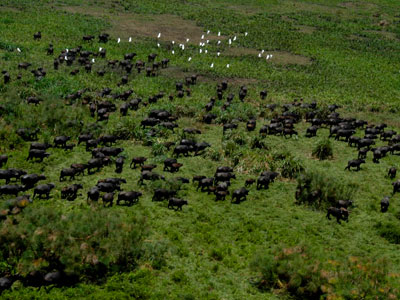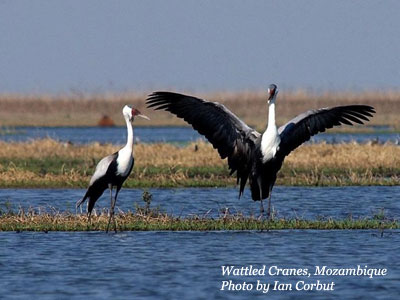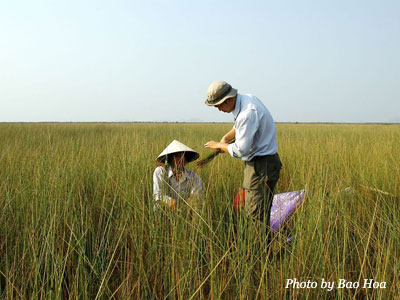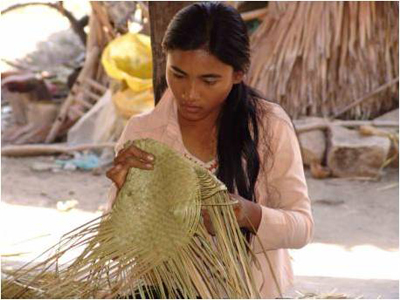 Cranes depend on some of the most amazing places on earth. But what does it mean to “save” these vital places? Some might imagine putting up a fence and locking the gate. But at the International Crane Foundation, we believe that the most lasting conservation solutions include, not exclude, the people who share their landscapes with cranes. Two recent success stories demonstrate our creative approach to saving places.
Cranes depend on some of the most amazing places on earth. But what does it mean to “save” these vital places? Some might imagine putting up a fence and locking the gate. But at the International Crane Foundation, we believe that the most lasting conservation solutions include, not exclude, the people who share their landscapes with cranes. Two recent success stories demonstrate our creative approach to saving places.
When I first visited the Zambezi River Delta of Mozambique in 1995, it had just emerged from a decade of brutal civil war, and almost nothing was known about the remaining wildlife. In search of the endangered
Wattled Cranes that once flourished in this remote area, and other signs of hope, we conducted an aerial survey of the delta. We discovered a treasure worth saving – an  immense mosaic of grasslands, savannas, and mangroves with African elephants and buffalo hiding deep in the floodplain swamps, and 58 breeding pairs of Wattled Cranes. We also observed tens of thousands of people whose livelihoods depended on the fisheries, forests, and other resources of the delta.
immense mosaic of grasslands, savannas, and mangroves with African elephants and buffalo hiding deep in the floodplain swamps, and 58 breeding pairs of Wattled Cranes. We also observed tens of thousands of people whose livelihoods depended on the fisheries, forests, and other resources of the delta.
Recognizing that this area represented one of the last opportunities on Earth to save a naturally-functioning river-delta for wildlife and people, we launched a now 20-year effort to save it. We conducted research on cranes, buffalo, and other associated species, explored ways for local inhabitants to sustainably use the delta’s resources for a better life, implemented measures to restore natural flooding patterns, and advocated for conservation action in the halls of government and on Mozambican television and radio.
Over time, our efforts brought national and international awareness to the delta, culminating with the 2005 designation of 1.7 million acres of the Zambezi Delta’s south bank as Mozambique’s first Wetland of International Importance under the Ramsar Convention — a strong commitment to sustaining the delta’s unique ecological and economic values. Our partner, the World Wildlife Fund, honored this success as a Gift to the Earth. Last December brought more great news – the government of Mozambique agreed to add the Zambezi Delta’s north bank to the Ramsar designation, increasing the conservation area to nearly 5 million acres – the largest protected coastal delta in the world!
 Across the Indian Ocean, another conservation success story was unfolding at the same time. Tran Triet, our Southeast Asia Program Director, who was then one of our sponsored graduate student at the University of Wisconsin-Madison, was conducting his dissertation research on the remnant wetlands of the Mekong River Delta when he discovered the natural wetlands of Phu My and its small population of endangered Sarus Cranes. Most of the delta’s 10 million acres of wetlands were drained during and after the Vietnam War and then developed for rice, and Triet sought to secure the few remaining wetlands for Sarus Cranes and other rare waterbirds.
Across the Indian Ocean, another conservation success story was unfolding at the same time. Tran Triet, our Southeast Asia Program Director, who was then one of our sponsored graduate student at the University of Wisconsin-Madison, was conducting his dissertation research on the remnant wetlands of the Mekong River Delta when he discovered the natural wetlands of Phu My and its small population of endangered Sarus Cranes. Most of the delta’s 10 million acres of wetlands were drained during and after the Vietnam War and then developed for rice, and Triet sought to secure the few remaining wetlands for Sarus Cranes and other rare waterbirds.
We approached Kien Giang Province to protect Phu My wetland, but provincial leaders — under national pressure to increase agricultural production — refused. Triet then began learning about how generations of the local Khmer people had used the wetland sedge Lepironia found at Phu My, which also serves as Sarus Crane habitat, to weave intricate handcrafts for their use.
production — refused. Triet then began learning about how generations of the local Khmer people had used the wetland sedge Lepironia found at Phu My, which also serves as Sarus Crane habitat, to weave intricate handcrafts for their use.
In 2002, we again approached the province to protect Phu My wetland, but this time our proposal focused on biodiversity conservation with livelihood improvement for the people who share this wetland — through the sustainable harvest and production of Lepironia handicrafts. The province gave us two years to demonstrate success, or they would convert the area to rice agriculture. Our proposal was awarded a World Bank Development Marketplace Award, and the Phu My Lepironia Wetland Conservation Project was born in September 2004.
What was supposed to be a two-year project has continued for more than a decade. And we delivered on our promises. Local families now earn a much higher income than before the project — better than they would earn growing rice on Phu My’s highly acidic soils. Sarus Crane numbers are increasing, and Phu My now supports the largest population in Vietnam. And the rare Lepironia wetlands are protected from development. Even more, we helped preserve Khmer traditional Lepironia handcrafts, provide high quality environmental education for school children, and provide training and research opportunities for students not only from universities nearby but also from other countries.
Phu My Project has won four international awards for its innovative approach and achievements. And this January, twelve years since allowing the International Crane Foundation to test a new conservation model in this sea of agriculture, Kien Giang Province declared the Phu My Species and Habitat Conservation Area as Vietnam’s newest protected area.
 There are many great efforts to save the key places that cranes depend on here in North America too. Last November, I participated in the Festival of the Cranes at Bosque del Apache National Wildlife Refuge in southcentral New Mexico, and learned of the great efforts underway by the U.S. Fish and Wildlife Service Refuge managers with support from the Friends of Bosque del Apache National Wildlife Refuge. By carefully stewarding the waters of the adjacent Rio Grande, and managing crops and runoff from surrounding agricultural fields, they maintain the most important wintering area for the Rocky Mountain population of Sandhill Cranes (supporting up to 15,000 birds each winter), as well as tens of thousands of snow geese and other migratory waterbirds. Thousands of visitors come to Bosque to experience the stunning fly-in of cranes and snow geese to their evening roost sites on the refuge, and learn about local conservation efforts. Click here to learn more about these efforts or join us in November 2016 for the next Festival of the Cranes at Bosque.
There are many great efforts to save the key places that cranes depend on here in North America too. Last November, I participated in the Festival of the Cranes at Bosque del Apache National Wildlife Refuge in southcentral New Mexico, and learned of the great efforts underway by the U.S. Fish and Wildlife Service Refuge managers with support from the Friends of Bosque del Apache National Wildlife Refuge. By carefully stewarding the waters of the adjacent Rio Grande, and managing crops and runoff from surrounding agricultural fields, they maintain the most important wintering area for the Rocky Mountain population of Sandhill Cranes (supporting up to 15,000 birds each winter), as well as tens of thousands of snow geese and other migratory waterbirds. Thousands of visitors come to Bosque to experience the stunning fly-in of cranes and snow geese to their evening roost sites on the refuge, and learn about local conservation efforts. Click here to learn more about these efforts or join us in November 2016 for the next Festival of the Cranes at Bosque.
These stories give me great hope for the future of cranes, and for the future of the amazing places on which cranes, and all of us, depend. Thanks to all our supporters for making these exciting success stories possible.
 Story submitted by Dr. Rich Beilfuss, President and CEO for the International Crane Foundation. Learn more about our work in Sub-Saharan Africa and South/Southeast Asia.
Story submitted by Dr. Rich Beilfuss, President and CEO for the International Crane Foundation. Learn more about our work in Sub-Saharan Africa and South/Southeast Asia.
